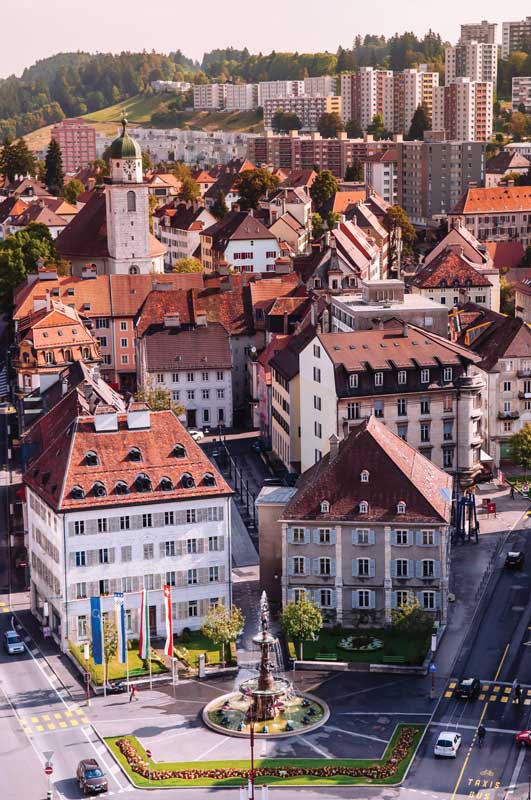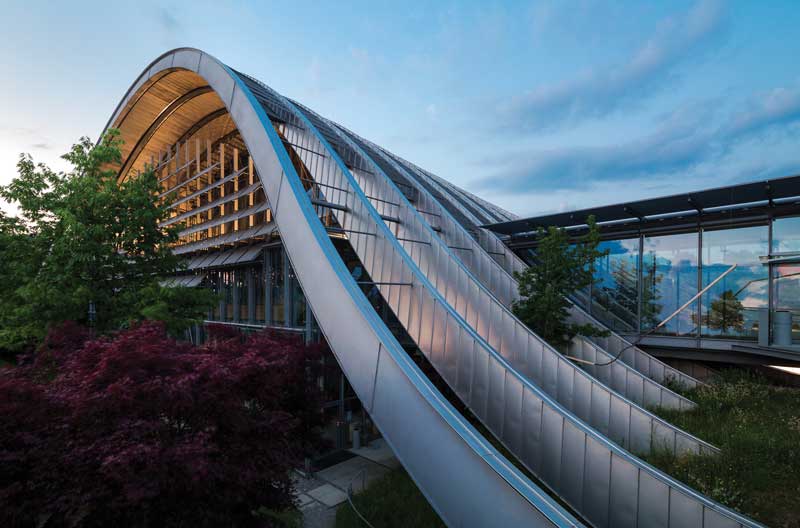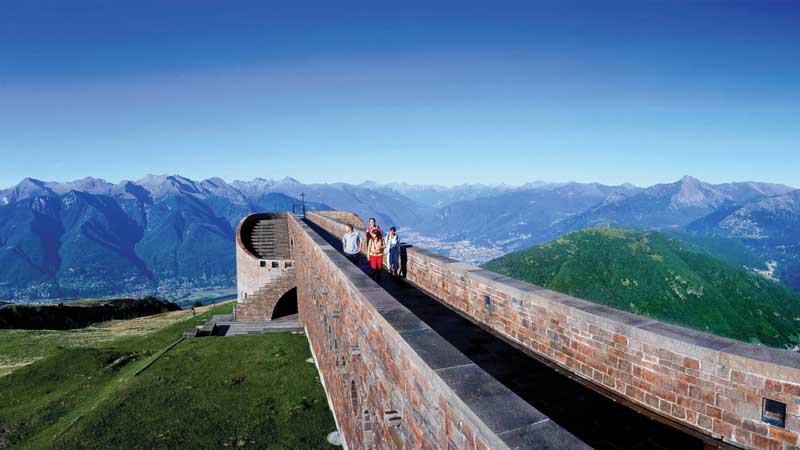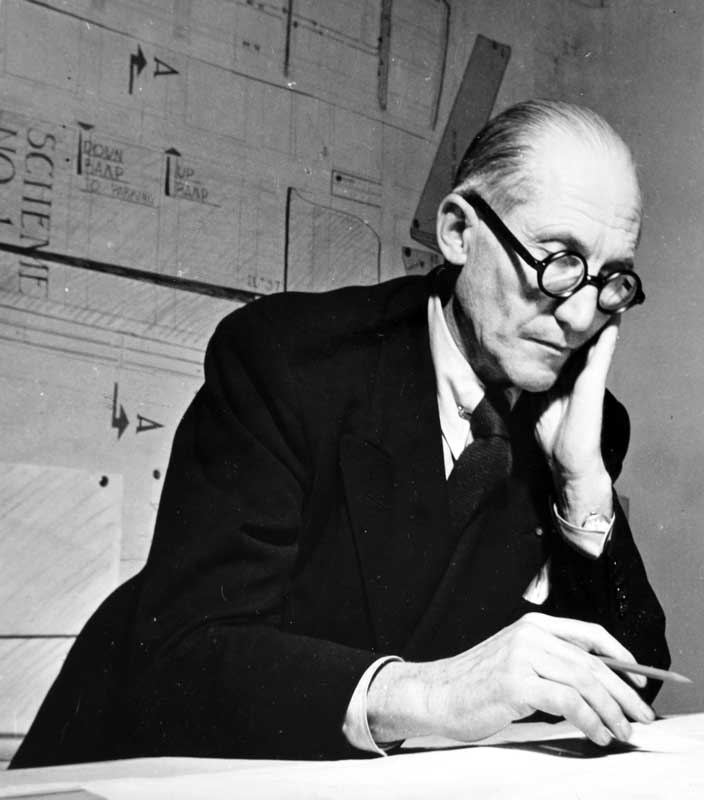In Switzerland, entire towns and villages retain much of their original structure. For example: Bern, declared a World Heritage Site by the United Nations Educational, Scientific and Cultural Organization (UNESCO).
The dwellings continue to reflect the regional autonomy of the country, from the stone houses of the Ticino, Engandine and Aspenzell regions, the Walser settlements, the half-timbered buildings of Eastern Switzerland, to the chalets of Bern and the dwellings of the Jura.
La Chaux-de-Fonds was the first industrial town on the planet and after a fire in the Jura Massif almost 200 years ago, its streets and buildings were restructured and organized. Later, UNESCO recognized it as a World Heritage Site, triggering an economic boom. Today, it is distinguished by its watchmaking expertise, combined with the richness of its cultural life and its particular architecture.
It is also a city where Art Nouveau was experienced to the full, and home to Le Corbusier's Villa Jeanneret-Perret and the crematorium of the architect and painter Charles L'Eplattenier.
Different styles – including Romanesque, Gothic, Renaissance, Baroque, Neoclassical, Art Nouveau and modern architecture – are represented throughout the country. Due to different traditions, climate and building materials, each district have certain particularities. For example: the chalet style, popular in the 19th century.
Since 1972, the Swiss Heritage Society annually awards the Wakker Prize in defense of Swiss cultural heritage, encouraging communities to preserve their appearance and ancient architecture.
Architecture before Le Corbusier
“The city was once quite illustrious, as attested by its half-ruined buildings.”
–Amiano Marcelino
Due to its strategic location as a trade route, Swiss architecture, along with various architectural traditions, was influenced by the four recognized national languages: German, French, Italian and Romansh.
It was the Romans, and later the Italians, who brought their style north over the Alps, with Germanic styles to the south and French influences to the east.
Ancient architecture spanned the years 4,000-500 B.C., its most characteristic feature being the buildings on stilts, erected by the Pfyn, Horgen, Cortaillod and La Tène cultures. In 58 B.C. after the defeat of the Helvetti at the Battle of Bribracte, during the following decades, Switzerland was incorporated into the Roman Empire: there is evidence of up to 20 villages settled in the first three centuries AD. It was not until the 4th century that the Roman army withdrew and Switzerland became a frontier province.
Thus the districts of Nyon and Augusta Raurica (today known as the Roman Museum of Augst) were abandoned, allowing their ruins to be used to fortify the cities of Geneva and Basel.
From the year 500 until the beginning of the Romanesque period in the 11th century, the pre-Romanesque or Carolingian architecture had strong influences of Byzantine and Christian architecture and was characterized by the emergence of new monasteries and churches in Western Europe. The Abbey of St. John – founded in 775 on the orders of Charlemagne and today a UNESCO World Heritage Site – is an example of this. The library of the Abbey of Saint Gall, which houses almost 2,100 manuscripts from the 8th to the 15th centuries, also stands out.
Romanesque architecture (11th to 12th centuries) was characterized by the construction of new churches, most of them in the same style: solid walls with few, small, round windows, groin vaults and, especially in religious temples, columns separating the naves from the aisles. It was the bishops of Basel, Chur, Geneva, Lausanne and Sion who ordered the construction of Romanesque cathedrals, such as the Priory of Sion.
In addition, fortresses and castles were erected along rivers and harbors as trade increased.
Gothic architecture, initiated in France, reigned from the 12th to the 16th centuries. When it arrived in Switzerland, churches were erected as a symbol of wealth and power; such was the case of the Cathedral of Lausanne. This was followed by the Renaissance period, which arrived in Switzerland around the 16th century and placed greater emphasis on symmetry, proportion and geometry. Many of the secular buildings north of the Alps were built in this style. Most were established in Basel in 1556.
Finally came Baroque architecture – whose main features were oval shapes in churches, spectacular use of natural light, trompe l'oeil illusions and the use of color – classicism was based on a return to ancient classical architecture in Rome and Greece and the architectural principles of Marcus Vitruvius (Utilitas, Venustas and Firmitas); Art Nouveau became popular in the 1880s, and until 1914, it was a revolution in art, architecture and decoration, inspired by natural forms, curved lines and flowing shapes.
About this last style, it arrived in Switzerland thanks to designers from all over Europe, and it was the industrial watchmaking town of La Chaux-de-Fonds the main exponent.
During the first half of the 20th century, modern architecture was born, and with it, great representatives such as Karl Coelestin Moser and Charles Edouard Jeanneret (Le Corbusier). It was based on new construction technologies, particularly in the use of materials such as steel, concrete and glass.
After World War II, modern architecture was the dominant style throughout the country. Later, in Ticino, architects such as Matio Botta, Tita Carloni, Luigi Snozzi, Bruno Reichlin and Fabio Reinhart developed a style based on Functionalism and Rationalism, incorporating contrasts with geometric designs and the use of local materials.
“The architecture is the starting point you want to lead humanity towards a better future.”
-Le Corbusier
An artist is born
"Architecture is a matter of harmonies, a pure creation of the spirit [...] In an instant, you touch my heart, you do me good, I feel happy and I say: this is beautiful, this is architecture, art enters me."
-Le Corbusier
It was not until the early 20th century that architects – visionary and courageous – came to the attention of the international public. In 1920, the theories of Walter Gropius' Bauhaus arrived in Switzerland, Le Corbusier was one of its main exponents.
In 1912 he presented his first building in Switzerland: the Villa Jeanneret-Perret. The last on the site was the Hedi Weber Museum in 1967. Since his concepts were not well accepted in the Swiss country, much of his work was focused abroad, but not before influencing a number of architects (local and international) who were inspired by his essence. Among them:
- Renzo Piano (Pritzker Prize 1998) built the Zentrum Paul Klee, whose roof curves mimic Bern's alpine peaks. As the name suggests, it contains about 40% of Paul Klee's paintings.
The Fondation Beyeler has housed the Beyeler family's art collection since 1997. Located in Basel, it has large windows that provide natural light to the interior.
- Jean Nouvel (Pritzker 2008), in collaboration with acoustical engineer Russell Johnson, designed KKL Luzern Concert Hall, whose cantilevers extend the horizontality of the lake into the heart of the city.
- Mario Botta (Pritzker 1990) built the impressive Fiore di pietra on Monte Generoso, a symbolic structure offering a breathtaking 360° view. He was also commissioned to rebuild the ancient Church of San Giovanni Battista in Mogno. Today, it stands as an architectural masterpiece against oblivion. Finally, he erected the religious building Cappella Santa Maria degli Angeli on Monte Tamaro.
- Peter Zumthor (Pritzker 2009) built the hotel 7132 in Vals, an internationally acclaimed architectural masterpiece. The complex was built in 1996 under a clear premise: to revolutionize the world of spas. The crown jewels of the project are the suites named House of Architects: seven hotel rooms designed by Tadao Ando (1), Kengo Kuma (1), Thom Mayne (4) and Zumthor himself (1).
- Local architects Herzog & de Meuron (Pritzker 2001) built the Hotel Astoria Luzern the architects' first hospitality-focused project.
- Norman Foster (Pritzker 1999) built the luxury apartment building Chesa Futura (House of the Future in Romansh) in St. Moritz, which combines state-of-the-art computer design tools with centuries-old construction techniques.
The natural landscapes of the Helvetic country are undoubtedly significant elements, from the ruins in the mountains to the lakes. It is a place where architecture and urbanism have been enhanced.
Text: ± Photo: : XNuvisage, drr, Arch Photos, Switzerland Tourism, Ryan, Bogdan Lazar









